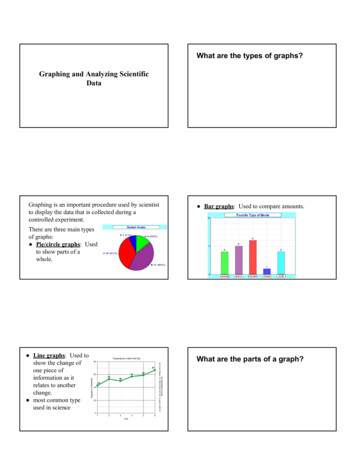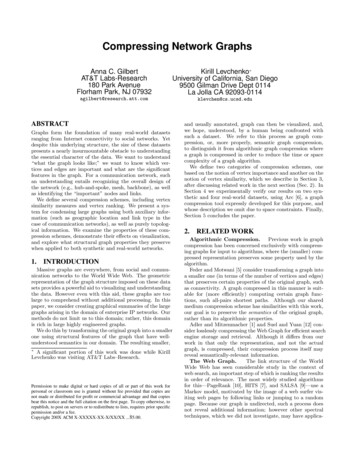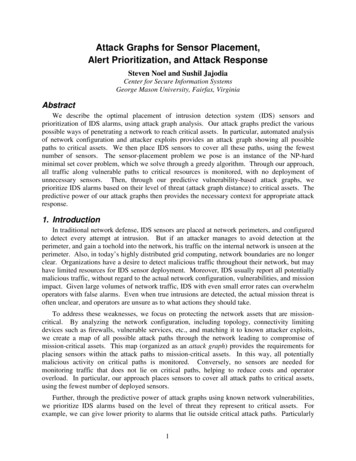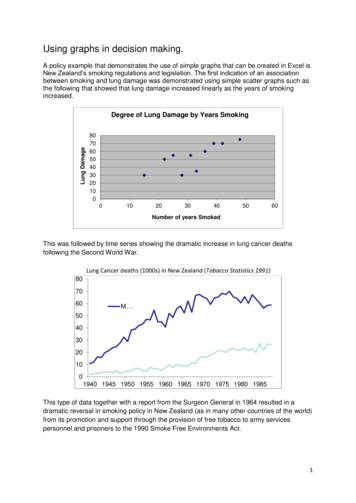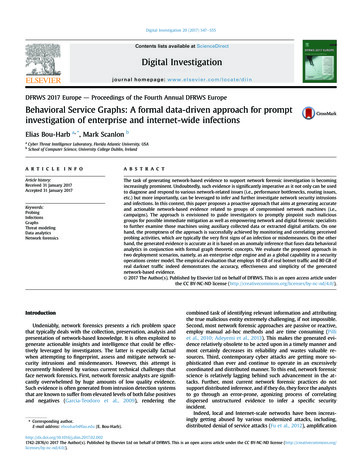
Transcription
Digital Investigation 20 (2017) S47eS55Contents lists available at ScienceDirectDigital Investigationjournal homepage: www.elsevier.com/locate/diinDFRWS 2017 Europe d Proceedings of the Fourth Annual DFRWS EuropeBehavioral Service Graphs: A formal data-driven approach for promptinvestigation of enterprise and internet-wide infectionsElias Bou-Harb a, *, Mark Scanlon babCyber Threat Intelligence Laboratory, Florida Atlantic University, USASchool of Computer Science, University College Dublin, Irelanda r t i c l e i n f oa b s t r a c tArticle history:Received 31 January 2017Accepted 31 January 2017The task of generating network-based evidence to support network forensic investigation is becomingincreasingly prominent. Undoubtedly, such evidence is significantly imperative as it not only can be usedto diagnose and respond to various network-related issues (i.e., performance bottlenecks, routing issues,etc.) but more importantly, can be leveraged to infer and further investigate network security intrusionsand infections. In this context, this paper proposes a proactive approach that aims at generating accurateand actionable network-based evidence related to groups of compromised network machines (i.e.,campaigns). The approach is envisioned to guide investigators to promptly pinpoint such maliciousgroups for possible immediate mitigation as well as empowering network and digital forensic specialiststo further examine those machines using auxiliary collected data or extracted digital artifacts. On onehand, the promptness of the approach is successfully achieved by monitoring and correlating perceivedprobing activities, which are typically the very first signs of an infection or misdemeanors. On the otherhand, the generated evidence is accurate as it is based on an anomaly inference that fuses data behavioralanalytics in conjunction with formal graph theoretic concepts. We evaluate the proposed approach intwo deployment scenarios, namely, as an enterprise edge engine and as a global capability in a securityoperations center model. The empirical evaluation that employs 10 GB of real botnet traffic and 80 GB ofreal darknet traffic indeed demonstrates the accuracy, effectiveness and simplicity of the generatednetwork-based evidence. 2017 The Author(s). Published by Elsevier Ltd on behalf of DFRWS. This is an open access article underthe CC BY-NC-ND license ).Keywords:ProbingInfectionsGraphsThreat modelingData analyticsNetwork forensicsIntroductionUndeniably, network forensics presents a rich problem spacethat typically deals with the collection, preservation, analysis andpresentation of network-based knowledge. It is often exploited togenerate actionable insights and intelligence that could be effectively leveraged by investigators. The latter is especially factualwhen attempting to fingerprint, assess and mitigate network security intrusions and misdemeanors. However, this attempt isrecurrently hindered by various current technical challenges thatface network forensics. First, network forensic analysts are significantly overwhelmed by huge amounts of low quality evidence.Such evidence is often generated from intrusion detection systemsthat are known to suffer from elevated levels of both false positivesand negatives (Garcia-Teodoro et al., 2009), rendering the* Corresponding author.E-mail address: ebouharb@fau.edu (E. Bou-Harb).combined task of identifying relevant information and attributingthe true malicious entity extremely challenging, if not impossible.Second, most network forensic approaches are passive or reactive,employ manual ad-hoc methods and are time consuming (Pilliet al., 2010; Adeyemi et al., 2013). This makes the generated evidence relatively obsolete to be acted upon in a timely manner andmost certainly decreases its reliability and wastes valuable resources. Third, contemporary cyber attacks are getting more sophisticated than ever and continue to operate in an excessivelycoordinated and distributed manner. To this end, network forensicscience is relatively lagging behind such advancement in the attacks. Further, most current network forensic practices do notsupport distributed inference, and if they do, they force the analyststo go through an error-prone, agonizing process of correlatingdispersed unstructured evidence to infer a specific securityincident.Indeed, local and Internet-scale networks have been increasingly getting abused by various modernized attacks, including,distributed denial of service attacks (Fu et al., 2012), 7.02.0021742-2876/ 2017 The Author(s). Published by Elsevier Ltd on behalf of DFRWS. This is an open access article under the CC BY-NC-ND license ).
S48E. Bou-Harb, M. Scanlon / Digital Investigation 20 (2017) S47eS55attempts (Kührer et al., 2014), spamming (Xie et al., 2008) andadvanced persistent threats (Daly, 2009). Such attacks are almostalways being generated by groups of infected and distributed machines controlled by an external entity (Silva et al., 2013). In thispaper, we refer to the latter orchestrated malicious groups as‘campaigns’. An effective approach to generate network forensicinsights and inferences related to those campaigns is to analyzetheir generated probing activities. Such activities refer to reconnaissance techniques that are typically employed by those campaigns to obtain information about their targets prior to launchingtheir targeted attacks (Allman et al., 2007). In fact, Panjwani et al.(2008) concluded that around 50% of attacks are indeed precededby some form of probing activity. Additionally, such activity hasbeen reported in numerous occasions as a concrete evidence ofinfection (Wang et al., 2014a; Whyte et al., 2006).In essence, the presented research and development work attempts to answer the following question: How can we design anapproach that is able to effectively process, analyze and correlate largevolumes of network traffic to generate, in a very prompt manner,formal, highly-accurate and actionable network forensic evidence thatcould be leveraged to infer infected campaigns?This paper attempts to answer this question. Specifically, thecore contributions of this paper could be summarized in thefollowing: Proposing a set of data behavioral analytics that scrutinizeperceived probing activities to capture their various obscuredfeatures (i.e., machinery, strategies, natures, etc.). The analyticsuniquely employ numerous statistical and entropy-based techniques to effectively generate feature vectors related to theinfected probing sources or hosts. Presenting Behavioral Service Graphs, a novel approach that aimsat providing investigators/analysts, network administratorsand/or security operators with network forensic evidencerelated to infected machines within a constructed campaign.The approach models the probing sources that show evidence ofinfection as graphs. By exploiting ancillary graph theoretic} s-Re nyiconcepts such as the maximum spanning tree and Erdorandom graphs, the approach is able to infer and correlate suchdistributed groups of infected machines. The approach isprompt since (1) it exploits probing activities to rapidly inferinfections and (2) the inferred group of infected machinespossesses the minimum number of members to formally claimthat such group is indeed a malicious campaign. The latter ideais especially imperative as this will allow actionable thwarting ofcampaigns as soon as there exists evidence of their construction. Empirically evaluating the proposed approach using two realand significant datasets under two different deployments scenarios. The output concurs that the extracted inferences exhibitnoteworthy accuracy and can generate significant, accurate andformal forensic insights that could be used for prompt mitigation and to facilitate further focused analysis.The road-map of this paper is as follows. In the next section, weelaborate on the proposed approach. Specifically, we disclose thedata preprocessing step, the employment of the data behavioralanalytics, the rationale and construction of Behavioral ServiceGraphs and detail how they can be exploited to achieve theintended goals. In Section Empirical evaluation, we empiricallyevaluate the proposed approach and verity its accuracy and insights. We provide a discussion related to the approach, its limitations and possible improvements in Section Proposed approach:limitations & possible improvements. In Section Related work, wesurvey the related work on various concerned topics. Finally, Section Concluding remarks summarizes the goals, the methods andthe results of the proposed approach and paves the way for futurework that aims at providing extended network-based evidence tofurther support investigations.Proposed approachIn this section, we describe and detail the rationale andemployed steps of the proposed approach. In a nutshell, the proposed approach (1) fingerprints and extracts probing activitiesfrom perceived network traffic, (2) applies the proposed behavioralanalytics to generate feature vectors related to the infected probingsources, (3) constructs Behavioral Service Graphs that model thoseprobing machines, and (4) manipulates such graphs to inferdistributed campaigns possessing minimum members of infectedmachines. The latter four steps are detailed next.Fingerprinting probing activitiesMotivated by the fact that probing activities precede a plethoraof attacks (Allman et al., 2007; Panjwani et al., 2008) coupled withthe rationale that such activities are the very first signs of anyinfection (Wang et al., 2014a; Whyte et al., 2006), the proposedapproach leverages the latter to extract probing activities generatedfrom infected machines. The intrusion detection system community provides extensive techniques on how to accomplish this task(Bhuyan et al., 2011). In this work, to successfully and accuratelyfingerprint probing activities, we leverage the work by Stanifordet al. (2002) and cross match the output, for validation purposes,by using two open-source detection systems, namely, Snort(Roesch et al, 1999) and Bro (Paxson, 1999). We have selected toemploy the latter three approaches as they are the de-facto standards when it comes to probing detection, possess the capability tooperate in real-time, and have been extensively and repetitivelyevaluated and validated. The output of this step is probing traffic,generated from unique sources, coupled with their network sessions that have been saved in packet capture (.pcap) format forfurther analysis.Data behavioral analyticsIn order to capture the behaviors of the inferred probing sources, we propose to employ the following set of behavioral analytics.This aims at generating the feature vectors of the infected probingmachines to be employed as input for the subsequent steps. Theproposed approach takes as input the previously extracted probingsessions and outputs a series of behavioral characteristics related tothe probing sources. In what follows, we pinpoint the concernedquestions and subsequently present the undertaken approach in anattempt to answer those.Is the probing traffic random or does it follow a certain pattern?When sources execute their probing traffic, it is imperative toinfer and capture the fashion in which they achieve their goal. Torealize this task, we proceed as follows. For each unique pair ofhosts extracted from the probing sessions (probing source totarget), we test for randomness of their inter-arrival times in thetraffic using the non-parametric Wald-Wolfowitz statistic test. Ifthe outcome is positive, we record it for that precise probing sourceand apply the test for the remaining probing sessions. If the result isnegative, we conclude that the generated traffic follows a certainpattern. To deduce the particular employed pattern, we model theprobing traffic as a Poisson distribution and capture the maximumlikelihood estimates for the Poisson parameter l that correspondsto that traffic, at a 95% confidence level. The choice to model thetraffic as a Poisson process is motivated by our previous work (Bou-
E. Bou-Harb, M. Scanlon / Digital Investigation 20 (2017) S47eS55S49Harb et al., 2016), where we have noticed that probe arrivals isconsistent with that distribution. Please note that we are notparticularly interested in the derived pattern values; we onlyemploy them to characterize the probing traffic to build the featurevectors of the probing sources.those distributions. The latter index is a conclusive metric of variety, randomness or uniformity in a distribution, regardless of thesample size. A result that is close to 0 points out that the probingsource is employing a targeted approach while an outcome valueclose to 1 means that its corresponding probing traffic is dispersed.How are the targets being probed?As shown in Dainotti et al. (2012), coordinated probing sourcesadopt numerous strategies when probing their targets. Thesestrategies could include IP-sequential, reverse IP-sequential, uniform permutation or other types of permutations. In an effort toinfer the probing strategies, we execute the following. For eachprobing source, we retrieve its corresponding distribution of targetIP addresses. To distinguish between sequential and permutationprobing, we leverage the Mann-Kendall statistic test, a nonparametric hypothesis testing approach, to check for monotonicity in those distributions. The rationale behind the monotonicity test is that sequential probing will indeed induce amonotonic signal in the distribution of target IP addresses whilepermutation probing will not. Moreover, in this work, we set thesignificance level to 0.5% since an elevated value could introducefalse positives. To discriminate between (forward) IP-sequentialand reverse IP-sequential, for those distributions that tested positive for monotonicity, we also take note of the slope of the distribution; a positive slope renders a forward IP-sequential strategywhile a negative one defines a reverse IP-sequential strategy. Forthose distributions that tested negative for monotonicity (i.e., not asequential strategy), we apply the chi-square goodness-of-fit statistic test (Anderson and Darling, 1954). The latter insight willnotify us whether or not the employed strategy is a uniform permutation; if the test returns a negative output, then the employedstrategy will be deemed as a permutation; uniform permutationotherwise.Miscellaneous inferencesFor each probing bot, we also record its rate (packets/second), itsratio of destination overlaps defined as r ¼ nc nt where nc definesthe number of common sessions between all the sources and nt istotal number of all probing sessions, and its target ports.It is evident that the latter set of behavioral analytics significantly rely on various statistical tests and methods to uncover thebehavior of the probing sources. We emphasize that such approachis arguably more sound than heuristics or randomly set thresholds.Further, it is noteworthy to indicate that all the employed statisticaltests assume that the data is drawn from the same distribution.Since the approach operates on one type of data, namely, networkdata extracted from a certain network topology, we can safelypresume that the values follow and are in fact drawn from the samedistribution.What is the nature of the probing source?It is of momentous importance as well to infer the nature of theprobing source; is it a probing tool or a probing bot. In this work, weare predominantly interested when the sources are bots as this willprovide more concrete evidence of infection. From the two preceding questions, we can deduce those probing events that arerandom and monotonic. It is known that monotonic probing is abehavior of probing tools in which the latter sequentially probetheir targets (IP addresses and ports). Additionally, for randomevents (i.e., events that do not disclose the use of certain patterns intheir inter-arrival times), the monotonic trend checking would aidin filtering out traffic caused by non-bot scanners (Li et al, 2011).Hence, we deem a probing source as employing a probing bot only iftheir traffic possesses pattern usage and if they adopt a probingapproach other than sequential probing (i.e., including reverse IPsequential); a probing tool otherwise. To this end, we acknowledge that this problem of classifying the nature of the probingsource is indeed challenging. Future work will attempt to furtherfortify the extracted evidence from our employed heuristic methodby investigating the correlation between the perceived probingtraffic and probing traffic extracted from malware samples.Is the probing targeted or dispersed?When sources probe their targets, it would be also beneficial toinfer whether their probing traffic is targeted towards a small set ofIP addresses or dispersed. In an attempt to answer this, for eachprobing source b, we denote GF(b) as the collection of flowsgenerated by that particular source. The destination target IP addresses used by the flows in GF(b) induce an empirical distribution.Consequently, we adopt the concept of relative uncertainty (Xuet al., 2005), an information theoretic metric and execute it onBehavioral Service GraphsWe model the probing machines that show signs of infection(i.e., those inferred as bots using the behavioral analytics) coupledwith their feature vectors using what we refer to as BehavioralService Graphs. Such graphs are of the form G ¼ ðN; EÞ where Nrepresents the set of infected probing sources/machines (i.e.,nodes) and E characterizes the edges between such nodes. It isworthy to mention that G is an undirected complete graph (Díazet al., 2002), with weights on the edges representing the probability of behavioral similarity (Pbs ) computed by piecewise comparisons between the previously inferred feature vectors of each ofthe nodes.To clarify how Pbs is computed, consider the above two featurevectors that capture the behavior of two distinct bots. By performing binary comparisons between each corresponding pair of
S50E. Bou-Harb, M. Scanlon / Digital Investigation 20 (2017) S47eS55features of those bots, one can note that the similarity is 3 6 or 50%.Please note that for the rate and destinations overlap features, weconsider a conservative 15% as being similar. It is also important tomention that we generate different complete graphs for differenttargeted port numbers that cluster a number of inferred bots. Thiswill indeed provide the capability to identify infected machinesparticipating in each unique campaign, given that there are multiple, simultaneously active different campaigns. Therefore, inessence, each constructed graph is actually modeling infectedmachines, their behavioral similarity and what specific networkservice is being probed. This aims at providing the investigator withadditional inference about the activities of the current infectionsand to warn about possible future attacks that could specificallyabuse that service.In summary, Behavioral Service Graphs allow the promptinference of bot infected machines by solely analyzing their probingactivities. Further, they extend such inferences to automate theamalgamation of evidence from distributed entities, as well asproviding auxiliary valuable insights related to the behaviors of theinfected machines and their possible intended actions.Friends of the enemy stay closely connected: inferring infectedcampaignsCampaigns of infected machines could be distinguished fromother security incidents as (1) the population of the participatingbots is several orders of magnitude larger, (2) the target scope isgenerally the entire Internet Protocol (IP) address space, and (3) thebots adopt well orchestrated, often botmaster-coordinated, stealthstrategies that maximize targets coverage while minimizingredundancy and overlap (Dainotti et al., 2015). In the context of anenterprise network, such campaigns not only hinder the legitimateusers' overall experience and productivity, but also jeopardize theentire cyber security of the enterprise (i.e., causing vulnerabilitiesor opening backdoors in the internal network). Further, theysignificantly degrade the provided quality of service since thecompromised machines will most often cause an excessive increasein bandwidth utilization that could be rendered by extreme peer topeer usage, spamming, command-and-control communicationsand malicious Internet downloads. Additionally, if the enterprisenetwork would be used to trigger, for instance, a malwareorchestrated spamming campaign, then such enterprise could aswell encounter serious legal issues for misusing its infrastructure(i.e., for example, under the US CAN SPAM Act (Parliament ofCanada; Governement of the USA)). Consequently, this willimmensely adversely affect the enterprise's business, reliability andreputation.To this end, forensic investigators of enterprise networks areinterested in possessing a capability that aims at inferring suchcampaigns of infected machines. However, one crucial requirementof such capability would be its promptness in deeming a group ofinfected machines as a campaign. In other words, the undertakenapproach would be required to provide tangible evidence related tothe minimum number of infected machines that compose acampaign. Indeed, this would generate actionable evidence thatcould be exploited to promptly thwart the expansion of thecampaign and thus would significantly limit the sustained possiblecollateral damage and any symptoms of infection. We next elaborate on such an approach.Previous work (Rajab et al., 2006) demonstrated that coordinated bots within a campaign probe their targets in a similarfashion. Indeed, Behavioral Service Graphs were initially engineered to naturally and intuitively support the latter; they clusterthe infected machines targeting the same service and they combinetheir feature vectors (and their similarly probability) for furtheranalysis. The proposed approach executes two steps to retrieve theminimum number of infected machines to deem a group of suchmachines as a campaign.First, given a complete Behavioral Service Graph G ¼ ðN; EÞ, theapproach extracts a subgraph G0 ¼ ðN 0 ; E0 Þ where N 0 ¼ N and E0 4E.This aims at reducing the number of edges while maximizing thebehavior probability between the infected machines (i.e., nodes). Toachieve this task, we employ the graph theoretic concept of amaximum spanning tree (Ozeki and Yamashita, 2011) by implementing a slightly modified version of Kruskal's algorithm (Kruskal,1956). Although there exists a plethora of approaches for the creation of maximum spanning trees, the latter algorithm was thebasis of many and is abundantly available in numerous tool sets.Second, to understand the structure of the subgraph formed bymembers of a botnet on the complete graph, suppose that there arem bots, thus forming a graph with m corresponding nodes. Let theset X ¼ fX1 ; X2 ; /; Xm g denote these nodes and Pe denote theprobability of having an edge between any given Xi and Xj , for i s jwhere 1 i m and 1 j m. Since Pe would exist with an equaland a random probability given any pair of Xi and Xj , the subgraphformed by the nodes X1 , X2 , /, Xm on a complete graph is indeed an}s-Re nyi random graph, where each possible edge in the graphErdopossesses an equal probability of being created.}s and Re nyi is that suchOne interesting property shown by Erdographs have a sharp threshold of edge probability for graph connectivity (Milo et al., 2002). Simplified, if the edge-probability isgreater than such threshold, then all of the nodes produced by such}s and Re nyi have showna model will be strongly connected. Erdothat the sharp connectivity threshold is ths ¼ lnq q, where q is thenumber of nodes in the graph. The proposed approach exploits thisneat graph theoretic property; given the previously extractedmaximum spanning tree subgraph, the approach eliminates allnodes/edges whose bot-edge probability (i.e., behavioral similarityPbs ) is less than ths , deeming the rest of the bots, given such formalforensic evidence, as the niche of the botnet.In conclusion, according to the random peer selection model,the niche members of the same infected campaign are expected tobe closely connected to each other on a subgraph extracted fromBehavioral Service Graphs.Empirical evaluationWe evaluate the proposed approach in two different deployment scenarios using two real datasets. This aims at validating theaccuracy, effectiveness and simplicity of the generated networkbased evidence as well as demonstrating the portability of theproposed approach.Scenario 1: enterprise capabilityIn this first scenario, Behavioral Service Graphs are employed toinfer infected machines within an enterprise network. Althoughthe notion of an enterprise network could extend to an Internetservice provider or even a backbone network, in this scenario, forsimplicity purposes, we depict a small department within an organization having a deployment setting similar to what is illustrated in Fig. 1. Such department includes 26 machines that areconnected to the Internet via an enterprise commodity edge server.The proposed approach is deployed on that server.Building the ground truthIn order to systematically assess the accuracy of the proposedscheme, one needs to know the IP addresses/hosts of the membersof the malicious campaign in a given network. Otherwise, nothingcan be said about the true positive or false alarm rate.
E. Bou-Harb, M. Scanlon / Digital Investigation 20 (2017) S47eS55S51Fig. 2. The creation of the Enterprise Complete and Sub Graphs.Fig. 1. The proposed approach deployed as an enterprise edge engine.In order to establish the ground truth for our experiment, weobtained 10 GB of real probing traffic retrieved from the Carnabotnet1 The latter orchestrated campaign is rendered as one of thelargest and most comprehensive IPv4 probing census ever. Subsequently, we presumed, as shown in Fig. 1, that 10 out of the 24machines are infected and thus are generating their maliciousprobing traffic towards the web service using TCP as the transportprotocol and 80 as the destination port number. We successfullyachieved this by substituting the IP addresses of the assumedinfected departmental machines with 10 IP addresses belonging to10 unique sources of the Carna botnet that are probing that service.To provide a realistic evaluation scenario, we now assume that wehave no knowledge about the infected departmental machines.Subsequently, we generated a legitimate background traffic datasetof 15 GB by leveraging the Security Experimentation EnviRonment(SEER) tool set2 and randomly merged it (using tcpslice3) with themalicious probing traffic dataset generated by those 10 IP addresses(z8 GB). The newly created merged dataset (of 23 GB) could bethought of as the network data generated by the departmentalmachines and received by the edge server, where the proposedapproach has been deployed for inference and analysis.EvaluationBy invoking the proposed approach on the merged dataset, theBehavioral Service Graph and its corresponding maximum spanning tree were inferred as depicted in Fig. 2. From a performanceperspective, it is worthy to note that processing the 23 GB datasetto generate the feature vectors as well as model the infected machines in complete and subgraphs and infer the niche of thecampaign required 8 min and 16 s using a commodity machinewith an Intel 3.4 GHz i7 processor with 16 GB of RAM. We believethat this iteration of the implementation of the proposed approaches, which exploit the C libcpap library for network processing and the C Boost Graph Library (BGL) for graphmanipulations, is quite efficient.A number of observations could be extracted from the completegraph (Fig. 2a). First, the number of assembled Behavioral ServiceGraphs is accurate; the approach generated one complete graphwhich is correct as the infected machines in the illustrated scenarioare probing only one service, namely, the web service. Second, thenumber of nodes in this Behavioral Service Graph is also precise;the approach inferred and correlated 10 infected machines which isconsistent with the number of infected departmental ://sourceforge.net/projects/tcpslice/.Third, after a semi-automated analysis and comparison that wasbased on the logged probing IP traffic flows, we identified that allthe 10 machines that the proposed approach has identified areindeed the same IP addresses of the infected departmental machines (i.e., the IP addresses of the Carna botnet). Therefore, basedon the latter three observations, we can claim that the proposedapproach yielded no false negative or false positive from a threatmodeling perspective.However, to further fortify the latter claim in an attempt togeneralize it as it applies to various network scenarios, we performed several other experiments. Specifically, we were interestedin evaluating the accuracy of the proposed approach as (1) thenumber of probed services increase in diversity and (2) as thenumber of infected machines scale up in a given network. Thus, wefirst augmented the number of probed services, one at a time, up to100 various probed TCP and UDP services. The results disclosed thatthe number of generated Behavioral Service Graphs remainedaccurately reflecting the number of probed services. Moreover, toverify the scalability of the proposed approach, we increased thenumber of ground truth infected machines, by slots of 100, up to1000 machines. The outcome disclosed consistent accuracy interms of constructed number of nodes and the positive infectionstate of such nodes. Such experiments relatively validate the accuracy and the scalability of the proposed scheme. Nevertheless, itis important to mention that by further executing scalability exp
Behavioral Service Graphs: A formal data-driven approach for prompt investigation of enterprise and internet-wide infections Elias Bou-Harb a, *, Mark Scanlon b a Cyber Threat Intelligence Laboratory, Florida Atlantic University, USA b School of Computer Science, University College Dublin, Ireland article info Article history: Received 31 .
